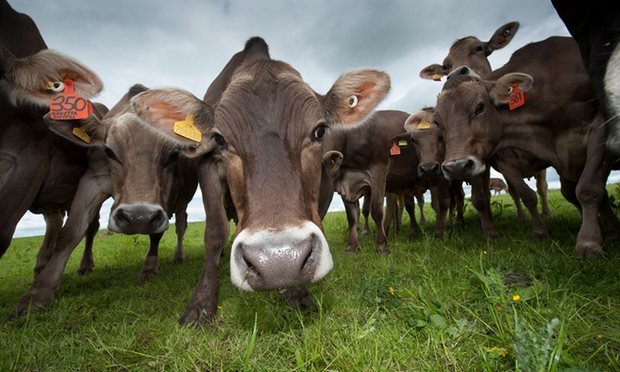Turning leftovers into renewable power makes ecological and financial sense, says farmer, but is it the best way to recycle Britain’s huge amount of wasted food?
 The UK produces nearly about 90m tonnes of organic waste from farms a year and about 10m tonnes of food waste, much of which still goes into landfill. Photograph: Alamy Stock Photo
The UK produces nearly about 90m tonnes of organic waste from farms a year and about 10m tonnes of food waste, much of which still goes into landfill. Photograph: Alamy Stock Photo
If electricity could be star-rated for quality, the 150 kilowatt hours going daily into the grid from Lodge Farm in north Wales would probably score five. Generated from the slurry of 300 brown Swiss and Norwegian red cattle, and topped up by chicken litter that cannot go to animal feed and by waste from the local Kellogg’s food factory, it is as good as it gets, says farmer Richard Tomlinson.
Since 2011, the gas from the organic farm’s £750,000 anaerobic co-digester (AD) has generated more than 4.5m kWh of electricity and heat for the farmhouse, an on-site engineering works and for 80-100 homes.
“But I am not turning the farm into a rural power station. My job is to grow food,” says Tomlinson, who co-founded one of Britain’s largest organic milk co-operatives.
Generating renewable power from farm and food waste makes ecological and financial sense, he says. The UK produces nearly 110m tonnes of organic waste a year, and 90m tonnes of that comes from farms. In addition, it produces about 10m tonnes of food waste, much of which still goes into landfill.
The stories you need to read, in one handy email
Read more
“Combining the two waste streams to produce heat, electricity and fertiliser closes the loop. It doesn’t make any sense for the slurry to move off the farms or for food to be landfilled. It makes much more sense to bring food waste here too and put it through the digester,” says Tomlinson, who with his brother has designed and built eight other farm-scale AD plants.
But the reality is many of Britain’s 208 anaerobic digestion plants that depend on food waste also take farmland out of production and use waste that could be fed to people or animals.
Because farm slurry is less efficient as a feedstock than other crops, many farmers have turned their fields to maize to feed the digesters. The NFU estimates about 15,000 hectares have been turned to growing maize for energy.
The food waste crisis in Britain costs businesses hundreds of millions of pounds a year in incineration and landfill fees, and, says the Waste Resources Action Programme (Wrap), is mostly avoidable.
“Anaerobic digestion is the best option for anything that cannot be used to feed animals or people,” says Tristram Stuart, who set up food waste campaign group Feedback. “But sending food waste into an AD plant only recovers a fraction of the energy that went into growing the food in the first place.
“Recycling tomatoes in this way, for example, generates less than 1% of the energy used to produce the crop. By contrast it’s up to 500 times better for the environment to divert food waste to pigs rather than sending it to AD,” says Stuart, who would like to see all food waste not fit for humans fed to animals. “Pigs eat our waste, we eat pigs: it’s a virtuous circle,” he says.
The future should be rosy for AD, with government backing until now and more food waste available for new plants. The fastest growth has been in Scotland, where the anaerobic digestion trade body, Adba, says 27 projects are now running, 43 more have planning approval and 12 more are seeking it.
But England lags well behind in separating food from other waste and the UK government is considering whether to cut all electricity generation subsidies from future AD plants with a capacity over 500MW. The result, says the nascent industry, could be contraction and less food waste being saved for energy.
“Ignoring the benefits of supporting renewable electricity growth now creates real risks. AD can deliver the same, vital baseload electrical capacity as new nuclear, but cheaper and faster than Hinkley Point C,” says Adba’s chief executive, Charlotte Morton.
“We throw a shocking amount of food waste into landfill because we have not collected it and treated it separately. There is an overwhelming economic and environmental case for doing so. The collection of food waste can play a significant part in helping the UK achieve its [50%] 2020 recycling targets,” says Fergus Healy, food waste and AD director at the energy company Olleco.
What our readers told us
We asked readers what they were doing to combat food waste. They told us about a project in Canada in which a combination of inedible food waste from Toronto grocery stores and manure from the city’s zoo are set to provide renewable energy for the Ontario grid.
The ZooShare biogas plant, which is predicted to be operational in December, is expected to reduce greenhouse gas emissions by the equivalent of 10,000 tonnes of C02 each year.
Harrison Jones